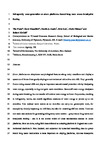Infragravity wave generation on shore platforms: Bound long wave versus breakpoint forcing
| dc.contributor.author | Poate, Timothy G. | |
| dc.contributor.author | Masselink, Gerd | |
| dc.contributor.author | Austin, MJ | |
| dc.contributor.author | Inch, Kris | |
| dc.contributor.author | Dickson, M | |
| dc.contributor.author | McCall, Robert Timothy | |
| dc.contributor.other | Faculty of Science & Engineering | en_US |
| dc.date.accessioned | 2020-03-16T09:54:32Z | |
| dc.date.available | 2020-03-16T09:54:32Z | |
| dc.date.issued | 2020 | |
| dc.identifier.uri | http://hdl.handle.net/10026.1/15455 | |
| dc.description | File replaced (incorrect version) 7/5/2020 by KT (LDS). | |
| dc.description.abstract |
Shore platforms are ubiquitous morphological features along rocky coastlines and display a spectrum of forms from gently-sloping to sub-horizontal with a low tide cliff. They generally front eroding coastal cliffs and play an important natural coastal protection role by dissipating wave energy, especially during energetic wave conditions. Sea-swell wave energy dissipates during wave breaking, but the transfer of incident wave energy to lower frequencies, resulting in infragravity waves, can enable significant amounts of wave energy to persist up to the shoreline. This residual wave motion at the shoreline can carry out geomorphic work, for example by directly impacting the cliff face, but also for removing cliff-toe debris. There are two main mechanisms for generating infragravity wave motion – group bound long waves and breakpoint forcing – and it is not known which of these mechanisms operate on shore platforms. Here we show, using field data collected at a sloping platform in England and a sub-horizontal platform in New Zealand, and supported by numerical modelling, that the group bound long wave mechanism is most important on sloping platforms, whereas breakpoint forcing dominates on sub-horizontal platforms. Our results also suggest that the infragravity wave motion on the sloping platform is somewhat more energetic than that on the sub-horizontal platform, implying that the latter type of platform may provide better protection to coastal cliffs. However, site-specific factors, especially platform elevation with respect to tidal level and platform gradient, play a key role in wave transformation processes on shore platforms and more field data and modelling efforts are required to enhance our understanding of these processes, especially collected under extreme wave conditions (Hs > 5 m). | en_US |
| dc.description.sponsorship | EPSRC | en_US |
| dc.language.iso | en | |
| dc.publisher | University of Plymouth | en |
| dc.rights | CC0 1.0 Universal | * |
| dc.rights.uri | http://creativecommons.org/publicdomain/zero/1.0/ | * |
| dc.subject | Shore platformsInfragravityWave transformation | en_US |
| dc.title | Infragravity wave generation on shore platforms: Bound long wave versus breakpoint forcing | en_US |
| dc.type | Other | en_US |
| plymouth.date-start | 2014-2015 | en_US |
| rioxxterms.funder | Engineering and Physical Sciences Research Council | en_US |
| rioxxterms.identifier.project | EP/L02523X/1 | en_US |



